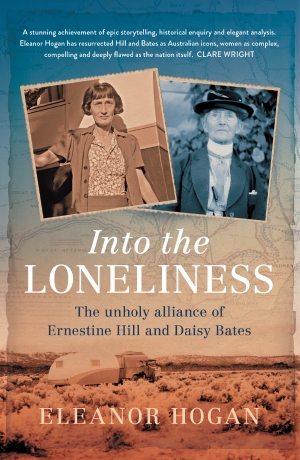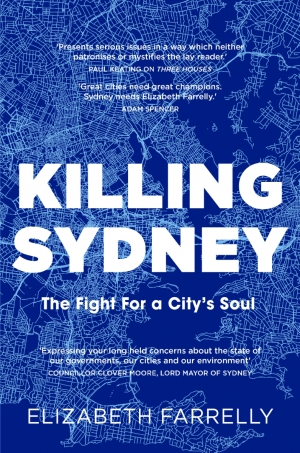NewSouth
Kim Mahood reviews 'Into the Loneliness: The unholy alliance of Ernestine Hill and Daisy Bates' by Eleanor Hogan
Into the Loneliness is the story of two Australian women, opposites in temperament, who eschewed the conventional roles expected of women of their eras, lived unconventional lives, and produced books that influenced the culture and imagination of twentieth-century Australia. The book focuses on their complicated friendship, and on Ernestine Hill’s role in assisting Daisy Bates to produce the manuscript that was published in 1938 as The Passing of the Aborigines, which became a bestseller in Australia and Britain. Hill, a successful and popular journalist, organised the anthropological material and ghost-wrote much of the book, for which Bates privately expressed her gratitude, while not acknowledging it publicly.
... (read more)Jacqueline Kent reviews 'Killing Sydney: The fight for a city’s soul' by Elizabeth Farrelly and 'Sydney (Second Edition)' by Delia Falconer
Poor old Sydney. If it isn’t being described as crass and culturally superficial, it’s being condemned for allowing developers to obliterate whatever natural beauty it ever had. Is it doomed, will it survive, and if so, what kind of city is it likely to be?
... (read more)Ashley Kalagian Blunt reviews 'Amnesia Road: Landscape, violence and memory' by Luke Stegemann
In 2019, the Spanish government exhumed the remains of General Francisco Franco from the Valley of the Fallen memorial to relocate them, bringing the controversial dictator alive in national debate in a way he hadn’t been for decades. Franco’s wasn’t the only body to resurface in Spain. Of the 170,000 non-combatants – innocent people – murdered during the Spanish Civil War of 1936–38, 115,000 were killed behind nationalist lines, then buried under decades of silence. In recent years, however, the people of Spain have begun unearthing mass graves, ordering DNA tests in search of lost relatives, and hotly arguing the historical and cultural narratives of Franco’s dictatorship.
... (read more)Marilyn Lake reviews 'Distant Sisters: Australasian women and the international struggle for the vote, 1880–1914' by James Keating
In July 1894, a year after New Zealand women had gained the national right to vote (the first in the world to do so), their spokesperson Kate Sheppard prepared to address a suffrage rally in London, alongside Sir John Hall, the parliamentary sponsor of the New Zealand suffrage campaign. They took the stage in the vast Queen’s Hall at Westminster to report on their historic fourteen-year struggle. In an age when oratorical skill defined public authority, Sheppard was, unfortunately, not a forceful speaker. She was evidently ill at ease on the platform and her voice ‘scarcely audible’, as historian James Keating reports in Distant Sisters, his meticulous account of Australasian women’s international activism in support of women’s suffrage between 1880 and 1914.
... (read more)Sarah Maddison reviews 'Truth-telling: History, sovereignty and the Uluru Statement' by Henry Reynolds
In the wake of the 2017 Uluru Statement from the Heart, truth-telling has gained new currency in Australia. The Statement called for a ‘Makarrata Commission to supervise a process of agreement-making between governments and First Nations and truth-telling about our history’. Although yet to be fleshed out in any detail, the renewed call for truth-telling has been greeted with enthusiasm by many First Nations peoples and their allies around the continent, who endorse the view that shining the bright light of truth into the darkest recesses of Australian history will contribute to a transformation in Indigenous–settler relations.
... (read more)Kate Burridge reviews 'Rooted: An Australian history of bad language' by Amanda Laugesen
‘Bad language’ comes in many forms, but, as the title suggests, the focus of Amanda Laugesen’s new book is on slang and, in particular, swear words. She documents Australia’s long and often troubled love affair with this language, dividing the history into four parts: the earliest English-speaking settlements of the eighteenth and nineteenth centuries; the period of Federation and World War I; the heart of the twentieth century; and the ‘bad language landscape’ of modern Australia. These four time periods highlight Indigenous stories as well as migrant contributions to the diverse swearing vocabulary of Australia.
... (read more)Rayne Allinson reviews 'Living with the Anthropocene: Love, loss and hope in the face of the environmental crisis' edited by Cameron Muir, Kirsten Wehner, and Jenny Newell
Last month I was volunteering with a group of botanists surveying coastal heathland in the Tarkine Forest Reserve in North-West Tasmania when one of them cried out, ‘Orchid!’ We all rushed over excitedly, our phones and pocket magnifiers at the ready. It was a Green-comb Spider-orchid (Caladenia dilatata), with long, delicate-green limbs and a reddish-purply face, hovering like a ballet dancer in mid-leap. The first thing that astonished me was how tiny it was – no bigger than a human eye – and then, how solitary. Like many orchids, C. dilatata uses sexual deception to mimic the shape of a female wasp; when males attempt to mate with it, they accidentally collect pollen, fertilising the next orchid they visit. Millions of seeds scatter on the wind, but only a few will land on a sunny patch of soil where the correct mycorrhizal fungus is present for it to germinate.
... (read more)Jay Daniel Thompson reviews 'Australian Women Pilots: Amazing true stories of women in the air' by Kathy Mexted
Kathy Mexted was a teenager when the possibility of becoming a pilot entered her head. The year was 1978, and she was airborne in a plane commanded by her father. The latter turned to his daughter and remarked: ‘If you’d like to learn to fly, I’ll pay for it.’ Nonetheless, it would take twelve years for the author to seriously pursue her piloting ambitions. This delay was due to several factors, not least of which was that flying has long been a ‘male dominated industry’.
... (read more)Morag Fraser reviews 'What Happens Next? Reconstructing Australia after Covid-19' edited by Emma Dawson and Janet McCalman and 'Upturn: A better normal after Covid-19' edited by Tanya Plibersek
What is to be done? The question is asked whenever humankind confronts a new crisis. And the answers, whether from biblical sources, Tolstoy, or Lenin (or indeed Barry Jones in his imminent book, What Is To Be Done?), must confront universal moral quandaries at the same time as they address local needs, hopes, and aspirations.
... (read more)Thucydides once said, ‘In a democracy, someone who fails to get elected to office can always console himself with the thought that there was something not quite fair about it.’ Chris Wallace is not inclined to agree with the Greek historian, particularly when dissecting the Labor Party’s shock federal election loss in 2019. In her latest book, How to Win an Election, Wallace nominates the ten things that Labor must get right to succeed at the next federal election, and self-pity is nowhere among them. This approach appears simplistic, even tongue-in-cheek at times, but she has captured the key elements of electoral success and makes a strong case that Australia cannot afford another ALP loss.
... (read more)









